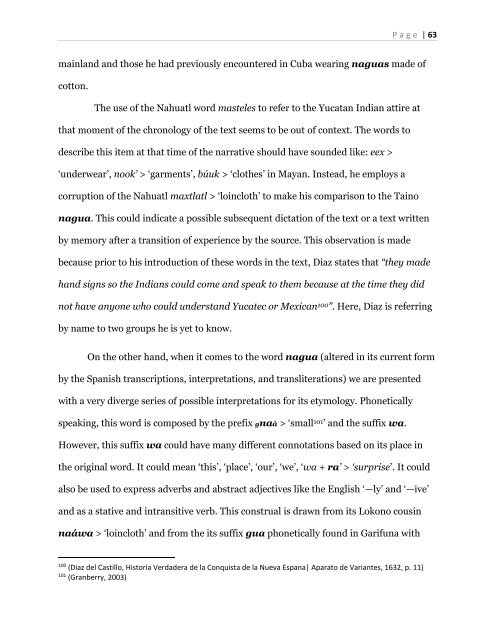Language of the Voiceless: Traces of Taino Language, Food, and Culture in the Americas From 1492 to the Present
by Leonardo Nin
by Leonardo Nin
Create successful ePaper yourself
Turn your PDF publications into a flip-book with our unique Google optimized e-Paper software.
P a g e | 63<br />
ma<strong>in</strong>l<strong>and</strong> <strong>and</strong> those he had previously encountered <strong>in</strong> Cuba wear<strong>in</strong>g naguas made <strong>of</strong><br />
cot<strong>to</strong>n.<br />
The use <strong>of</strong> <strong>the</strong> Nahuatl word masteles <strong>to</strong> refer <strong>to</strong> <strong>the</strong> Yucatan Indian attire at<br />
that moment <strong>of</strong> <strong>the</strong> chronology <strong>of</strong> <strong>the</strong> text seems <strong>to</strong> be out <strong>of</strong> context. The words <strong>to</strong><br />
describe this item at that time <strong>of</strong> <strong>the</strong> narrative should have sounded like: eex ><br />
‘underwear’, nook’ > ‘garments’, búuk > ‘clo<strong>the</strong>s’ <strong>in</strong> Mayan. Instead, he employs a<br />
corruption <strong>of</strong> <strong>the</strong> Nahuatl maxtlatl > ‘lo<strong>in</strong>cloth’ <strong>to</strong> make his comparison <strong>to</strong> <strong>the</strong> <strong>Ta<strong>in</strong>o</strong><br />
nagua. This could <strong>in</strong>dicate a possible subsequent dictation <strong>of</strong> <strong>the</strong> text or a text written<br />
by memory after a transition <strong>of</strong> experience by <strong>the</strong> source. This observation is made<br />
because prior <strong>to</strong> his <strong>in</strong>troduction <strong>of</strong> <strong>the</strong>se words <strong>in</strong> <strong>the</strong> text, Diaz states that “<strong>the</strong>y made<br />
h<strong>and</strong> signs so <strong>the</strong> Indians could come <strong>and</strong> speak <strong>to</strong> <strong>the</strong>m because at <strong>the</strong> time <strong>the</strong>y did<br />
not have anyone who could underst<strong>and</strong> Yucatec or Mexican 100 ”. Here, Diaz is referr<strong>in</strong>g<br />
by name <strong>to</strong> two groups he is yet <strong>to</strong> know.<br />
On <strong>the</strong> o<strong>the</strong>r h<strong>and</strong>, when it comes <strong>to</strong> <strong>the</strong> word nagua (altered <strong>in</strong> its current form<br />
by <strong>the</strong> Spanish transcriptions, <strong>in</strong>terpretations, <strong>and</strong> transliterations) we are presented<br />
with a very diverge series <strong>of</strong> possible <strong>in</strong>terpretations for its etymology. Phonetically<br />
speak<strong>in</strong>g, this word is composed by <strong>the</strong> prefix gnaá > ‘small 101 ’ <strong>and</strong> <strong>the</strong> suffix wa.<br />
However, this suffix wa could have many different connotations based on its place <strong>in</strong><br />
<strong>the</strong> orig<strong>in</strong>al word. It could mean ‘this’, ‘place’, ‘our’, ‘we’, ‘wa + ra’ > ‘surprise’. It could<br />
also be used <strong>to</strong> express adverbs <strong>and</strong> abstract adjectives like <strong>the</strong> English ‘—ly’ <strong>and</strong> ‘—ive’<br />
<strong>and</strong> as a stative <strong>and</strong> <strong>in</strong>transitive verb. This construal is drawn from its Lokono cous<strong>in</strong><br />
naáwa > ‘lo<strong>in</strong>cloth’ <strong>and</strong> from <strong>the</strong> its suffix gua phonetically found <strong>in</strong> Garifuna with<br />
100<br />
(Diaz del Castillo, His<strong>to</strong>ria Verdadera de la Conquista de la Nueva Espana| Apara<strong>to</strong> de Variantes, 1632, p. 11)<br />
101<br />
(Granberry, 2003)


















